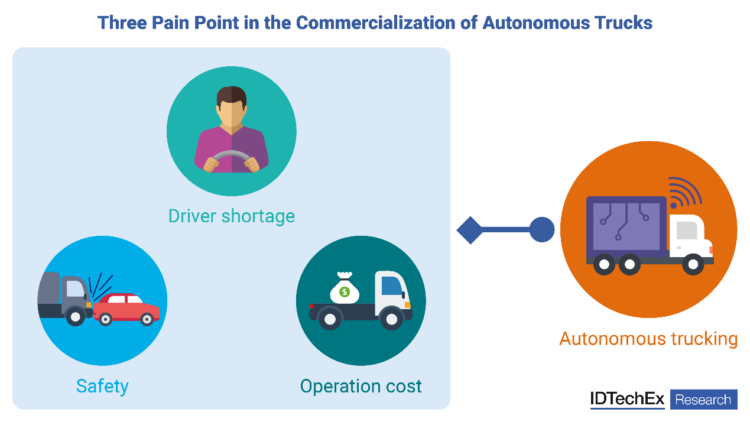Pain points in the commercialization of autonomous trucks
Trucks have long been regarded as having great potential in commercializing autonomous driving systems. Compared to
robotaxis and other mobility-service-oriented autonomous platforms, companies do not need to focus as much on user experience or integration within society. The purpose of autonomous driving systems in trucks is to address several critical issues within the industry, with driver management being the most prominent. Unstable social conditions and COVID-19 have deterred many from becoming truck drivers. Many young people are reluctant to spend their lives on the road when homeworking has become a viable way to build a career. The aging population exacerbates the labor shortage, making waning driver numbers cause a bottleneck in land transportation. Fewer drivers mean carriers are forced to increase wages to attract new and suitable drivers, thus raising operating costs.
Safety is another crucial consideration in the trucking industry. According to “Intelligent Safety White Paper for China’s Road Freight Industry,” there are 3.7 accidents per million kilometers in China’s freight industry – equivalent to one traffic accident per driver every 16 months. The annual insurance payout is about RMB 30,000 per vehicle (US$4,286), with 37% of accidents attributed to driver error and 35% related to the lack of assisting equipment. Data from the Federal Motor Carrier Safety Administration indicates that heavy-duty trucks and buses in the United States have 0.1 accidents per million kilometers, with 1% being fatal. The significant disparity arises from differences in road traffic infrastructure between western and eastern China, differences in management regulations between developed and underdeveloped areas, and reduced insurance costs and personal injury compensation.
Using autonomous long-haul trucks has the potential to reduce the number of accidents, as autonomous driving systems do not get distracted and can facilitate more efficient and effective communication with other
vehicles or devices.
The commercialization path of autonomous trucks
In 2024, autonomous truck companies are actively conducting commercial testing in the hope of addressing the paint points listed above.
Led by Inceptio, the first path involves gradually upgrading the in-vehicle autonomous driving system from Level 2 to Level 4 . The goal is to utilize L2 advanced driver assistance systems (ADAS) to pave the way for commercialization and gather real-world data to prepare for L4 autonomous driving systems. Although L2 cannot replace drivers, it can alleviate fatigue, extend driving distances, and enhance safety. In the Chinese market, carriers can drop from two drivers to just one on longer routes thanks to the convenience and safety available from L2-L3 ADAS trucks.
The second path focuses on establishing high-quality L4 fixed routes (called “hub-to-hub”) for short-distance (200-400 miles) autonomous or unmanned transportation. Sweden’s Einride is a notable example of a company doing this, with three route plans in the UK, Norway, and Sweden. Companies need to pre-plan the routes for downstream transportation customers and set up related auxiliary facilities along the way to ensure the smooth operation of L4 autonomous driving. As an electric truck company, Einride has designed an autonomous driving network called “Grids” to address fleet optimization, tractor swaps, and
battery management optimizations. Einride is already operating independently in Europe and the United States.
Commercialization representatives in three continents
China
China was the first to achieve the mass production and commercial delivery of autonomous trucks. Inceptio and DeepWay have made significant sales in their respective sectors—internal combustion engine (ICE) and pure electric. These companies leverage vertical integration, supply chain dominance, and economies of scale to solidify their early lead and extend their dominance into foreign markets.
Europe
Einride stands out as a leader in Europe, achieving L4 level commercial operations in three regions. Einride boasts a highly integrated management platform that oversees fleet operations, energy management, and freight volumes.
United States
The United States was the earliest to begin L4 level truck road testing, with numerous players involved. Kodiak and Aurora have accumulated leading global test mileage. However, regulatory challenges have slowed commercialization progress, with mass production expected in the coming years.








